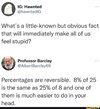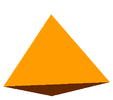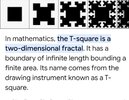dogs105
Sweet Kennels Proprietor
Starting off with a fun one, as a lot of people "know" that exponential growth is fast, they underestimate how quickly it actually increase.
Imagine you were drawing a graph of a simple exponential, y=2^x. You have a maths book with 1cm squares in a grid. Starting at the bottom left corner you start plotting the points (0,0), (1,2), (2,4), (3,8) etc. and get the familiar exponential curve that you only ever draw the start of.
After just 5cm on the x axis, your graph has gone off the top of the page.
As you move across about 14 cm (5ish inches), you page would need to be bigger than the height of the London Eye to fit your graph.
By the time you get to the width of your A4 page, your graph is stretching 21km in the air - over 2 and a half times the height of Mount Everest.
If you have an x coordinate of 36 cm - just longer than a regular ruler, your y coordinate is greater than the distance from the earth to the moon.
Imagine you were drawing a graph of a simple exponential, y=2^x. You have a maths book with 1cm squares in a grid. Starting at the bottom left corner you start plotting the points (0,0), (1,2), (2,4), (3,8) etc. and get the familiar exponential curve that you only ever draw the start of.
After just 5cm on the x axis, your graph has gone off the top of the page.
As you move across about 14 cm (5ish inches), you page would need to be bigger than the height of the London Eye to fit your graph.
By the time you get to the width of your A4 page, your graph is stretching 21km in the air - over 2 and a half times the height of Mount Everest.
If you have an x coordinate of 36 cm - just longer than a regular ruler, your y coordinate is greater than the distance from the earth to the moon.










